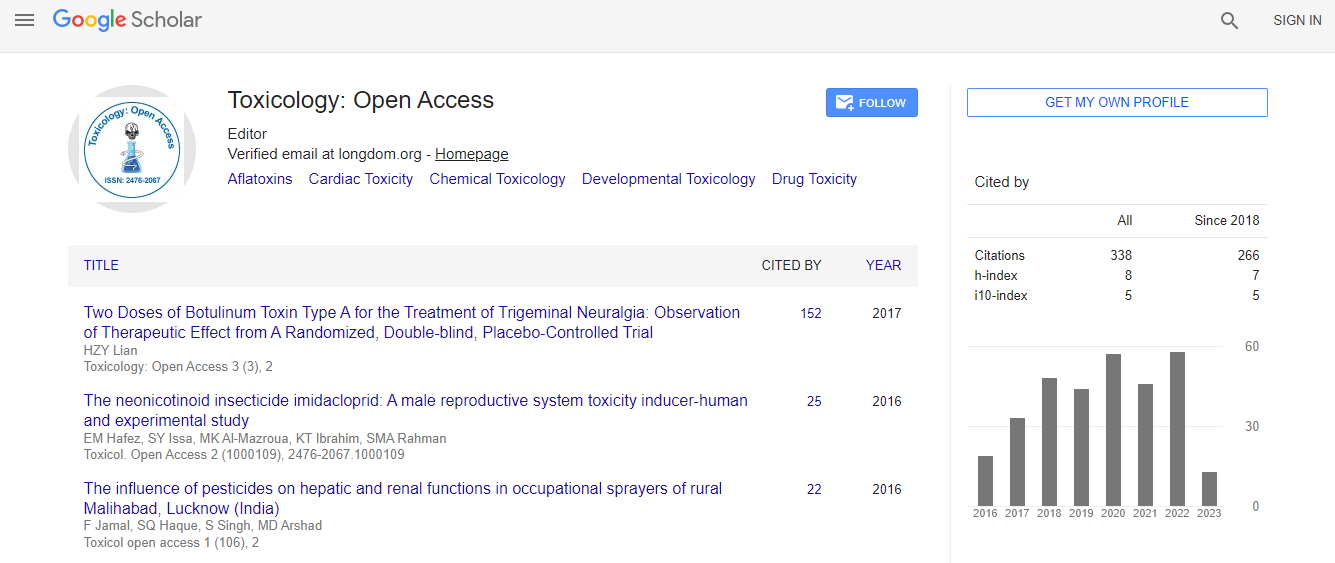Our Group organises 3000+ Global Conferenceseries Events every year across USA, Europe & Asia with support from 1000 more scientific Societies and Publishes 700+ Open Access Journals which contains over 50000 eminent personalities, reputed scientists as editorial board members.
Open Access Journals gaining more Readers and Citations
700 Journals and 15,000,000 Readers Each Journal is getting 25,000+ Readers
Google Scholar citation report
Citations : 336
Toxicology: Open Access received 336 citations as per Google Scholar report
Indexed In
- Google Scholar
- RefSeek
- Hamdard University
- EBSCO A-Z
- Geneva Foundation for Medical Education and Research
- Euro Pub
- ICMJE
Useful Links
Related Subjects
Share This Page
Roles of ATP7B gene to maintain the copper-transporting ATPase in a HepG2 cell line against excess copper toxicity
14th World Congress on Toxicology and Pharmacology
Shikha Agnihotry, Jaya Upadhayay, Pradeep K Shukla and Budhayash Gautam
Sam Higginbottom University of Agriculture, Technology and Sciences, India
Posters & Accepted Abstracts: Toxicol Open Access
Abstract
Wilson disease (WD) is an autosomal recessive disorder of copper transport with a worldwide frequency of ~1 in 30000. Wilsonâ�?�?s disease is characterized by chronic liver and neurological disease and also reported in kidney. Hepatic copper levels vary among normal individuals and WD patients depending upon on dietary copper intake and bioavailability, as well as genetic factors. In this study we examined that abnormal copper accumulation in human hepatocarcinoma (HepG2) cell line. Copper chloride (CuCl2) caused dose dependent cell viability reduction of human hepatocarcinoma (HepG2) cell line which was measured through MTT assay. We used different concentration of CuCl2 in their log doses but maximum cell viability reduction was recorded at 15 �?µg/ml. It also induces cell cycle arrest and DNA damage due to intracellular ROS generation. CuCl2 induces Ca2+ release from endoplasmic reticulum (ER) and leads to apoptotic cell death. It causes the up-regulation of WD stress marker genes ATP7B and Cyp1A1, Cyp1A2 at transcription levels. The similar response of ATP7B and Cyp1A1, Cyp1A2 proteins was recorded at translation levels. Heavy dietary intake of CuCl2 induces mitochondria and reduced the mitochondrial membrane potential analyzed through JC-1 staining. It further increases Bax/Bcl2 ratio and promotes the release of cytochrome C, finally leads to caspase-dependent apoptosis. Up-regulation of APAF1 in CuCl2 treated cells supports the mitochondrial-mediated apoptotic cell death. The results support the involvement of ER and mitochondria in ROS mediated CuCl2 toxicity. Therefore, the heavy dietary intake of CuCl2 in food products may be deleterious to users. References 1. Brady A H, Stein H A, Turschner S, Toegel I, Mora R, Jennewein N, Efferth T, Eils R, Brady N R (2011) Artesunate activates mitochondrial apoptosis in breast cancer cells via iron-catalyzed lysosomal reactive oxygen species production. J. Biol. Chem.; 286: 6587â�?�?6601. 2. Kroemer G, Reed J C (2000) Mitochondrial control of cell death. Nat. Med.; 6: 513â�?�?519. 3. Hart E B, Steenbock H, Waddell J (1928) Iron nutrition. VII: Copper is a supplement to iron for hemoglobin building in the rat. The Journal of Biological Chemistry; 77: 797â�?�?833.Biography
Shikha Agnihotry has been working as Research Assistant at Sanjay Gandhi Postgraduate Institute of Medical Sciences, Lucknow of ICMR since 2013. She has been involved in training biomedical research scholars in the field of bioinformatics and has also assisted as Research Assistant under an ICMR-funded project.
Email:shikha25agnihotry@gmail.com

 Spanish
Spanish  Chinese
Chinese  Russian
Russian  German
German  French
French  Japanese
Japanese  Portuguese
Portuguese  Hindi
Hindi 